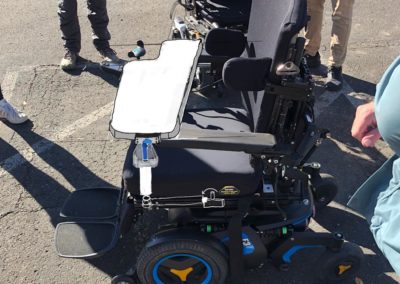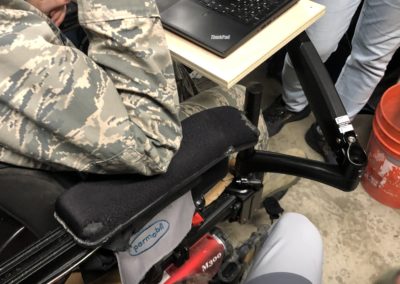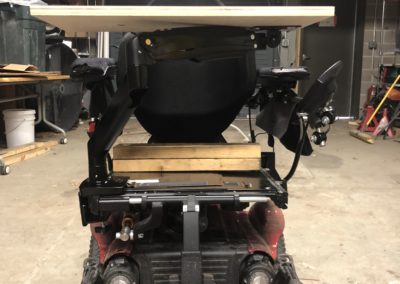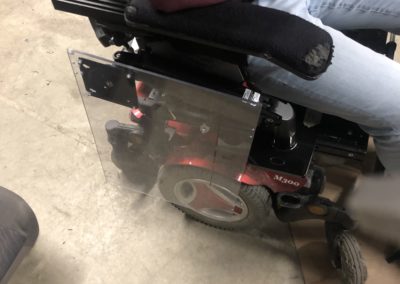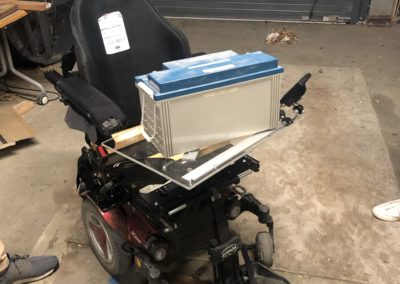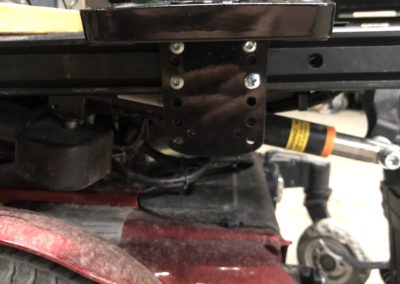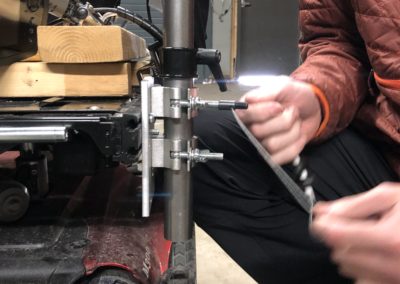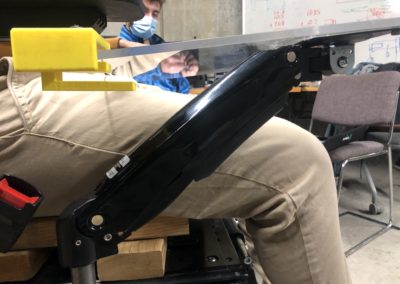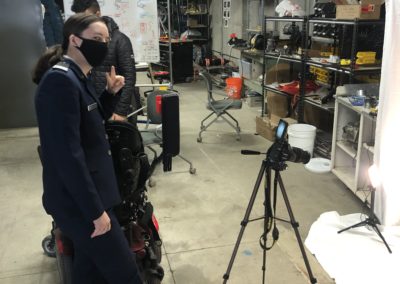Craig Hospital Low-Cost Laptray Team – Aspire
Overview
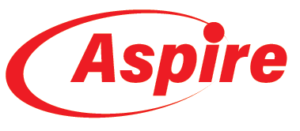 The team “Aspire” worked with Patrick Wagner, Rehabilitation Engineer at Craig Hospital, to develop an adaptive table tray and work surface for wheelchair-bound individuals.
The team “Aspire” worked with Patrick Wagner, Rehabilitation Engineer at Craig Hospital, to develop an adaptive table tray and work surface for wheelchair-bound individuals.
Desks and tables do not always accommodate wheelchair–bound people, and while solutions exist for attachable mounting surfaces, not all clients are able to afford the often-exorbitant costs of any extra features that are not covered by insurance. To that end, the following design requirements were provided to the team:
- Needs to be easily adjustable for users with a limited range of motion (i.e. extension, rotation, etc.)
- Needs to be stable (no “give” or “wobble” with applied loads)
- Should not interfere with the user (i.e. rest on a user’s legs)
- Material composition should be clear so the user can see their legs
- Should be lightweight
- Should be able to be mounted to various wheelchairs
- Needs to be easily stowable for daily use
These requirements will enable wheelchair users to gain independence in where and when they work. The team noted it is important to execute this project while keeping stakeholder feedback in mind, so the finished product will achieve the needs of any user.
The team applied mechanical engineering principles throughout the design process and assessed the design during iterative prototype testing stages, especially when creating the mount and considering the interface between the mount and the power wheelchair. From this approach, Team Aspire was able to successfully design and produce an innovative lap tray attachment for power wheelchairs.
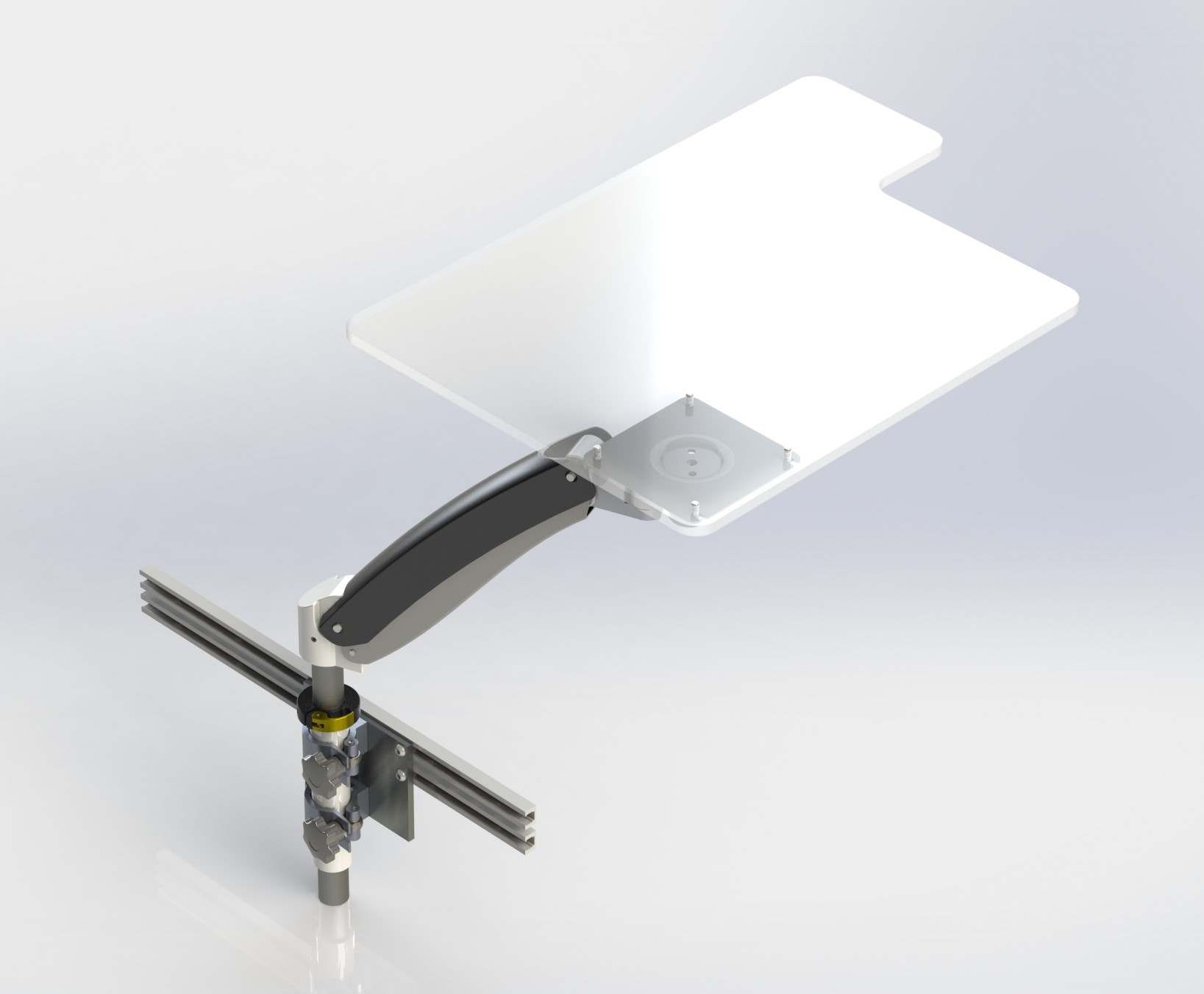
Live Zoom Chat
Use the link below to join us live from 8:00 – 10:30 a.m. on April 29th.
Join from PC, Mac, Linux, iOS or Android: https://mines.zoom.us/j/95672131027
Or iPhone one-tap: 16699006833,95672131027# or 12532158782,95672131027#
Or Telephone:
Dial: +1 669 900 6833 (US Toll) or +1 253 215 8782 (US Toll)
Meeting ID: 956 7213 1027
International numbers available: https://mines.zoom.us/u/amQGev10p
Team Members
- Hamood Al-harthi
- Maxwell Hacker
- Clinton Hemphill
- Emma Myhre
- Chelsea Pearson
- Grant Scott
The Client
- Patrick Wagner – Craig Hospital
Acknowledgements
Project Advisor: Dr. Kristy Csavina
Technical Advisor: Dr. Jeffrey Ackerman
Video
Elevator Pitch
The overall goal of this project was to produce a low-cost work surface for use on motorized wheelchairs. The previously mentioned design criteria, combined with the end goal of a low-cost final product, resulted in a great deal of designing, building, testing, and modification to reach the final product. Each iterative prototype met a specific design function, and through testing and review with the client, Team Aspire made changes to better address the needs of the end-user and to improve functionality. As the process continued toward the final design, the team obtained more specific details regarding the broad goals originally laid out. The team continually modified the apparatus, improving mounting aspects and unique features (such as the armrest extensions) until the Design Showcase. Unfortunately, COVID-19 restrictions prevented the team from adequately testing the prototype with actual motorized wheelchair users. The team recommends that Craig Hospital completes user testing prior to production.
Design Approach
The team focused on the primary design criteria of creating a safe and affordable lap tray while considering the design constraints defined at the beginning of the project. The main subsystems of this design include the tabletop, the stowing mechanism, and the mount. A visualization/model of the design and goals of each subsystem is provided below.
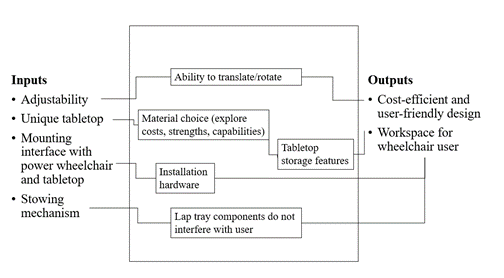
Initially, Team Aspire had many ideas for what a good final product should look like and prioritized creating an innovative product during the design stages of the project. The team divided into three groups prior to the Preliminary Design Review to present a variety of designs to the client. These ideas incorporated multiple unique components, the most complex being a tabletop split in two halves connected by strong magnets with an intricate mounting arm assembly unit and stowage mechanism. Another complicated design utilized a ball-joint system with many degrees of freedom and a heavy mount that would be difficult for a caretaker to install. After presenting these ideas to the client representative, it was evident that other characteristics were more important to prioritize during design phases. Safety, usability, and cost became the main criteria for making design choices from then on. Once the team focused on improving the functionality of the lap tray and simulating future user movements of the tabletop, the team located numerous aspects of the design that could be improved upon, eventually leading to a cohesive and unique solution.
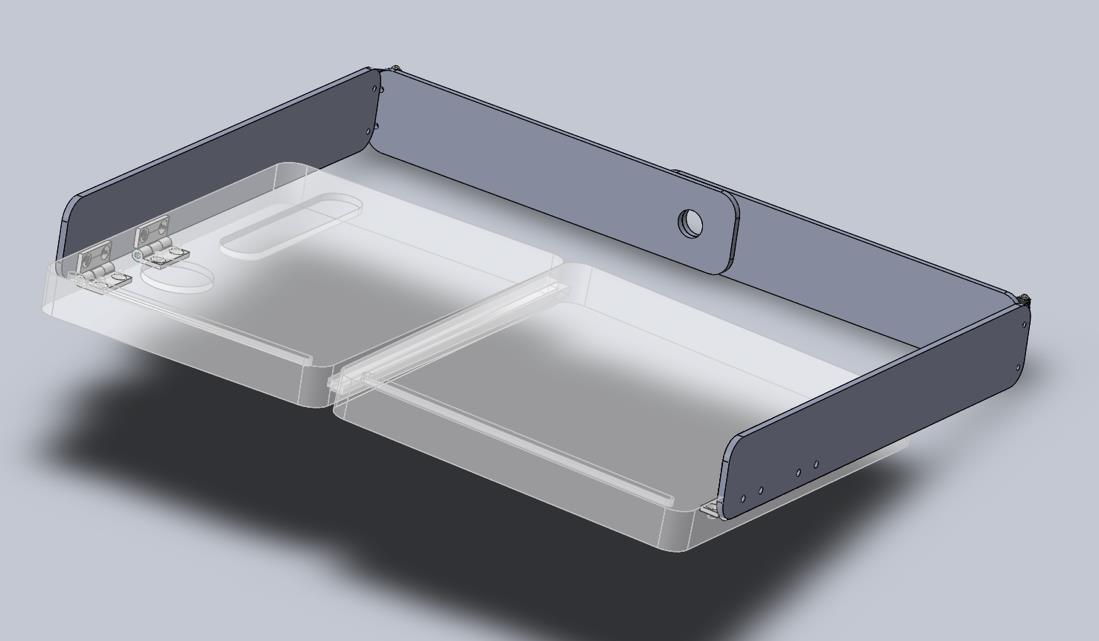
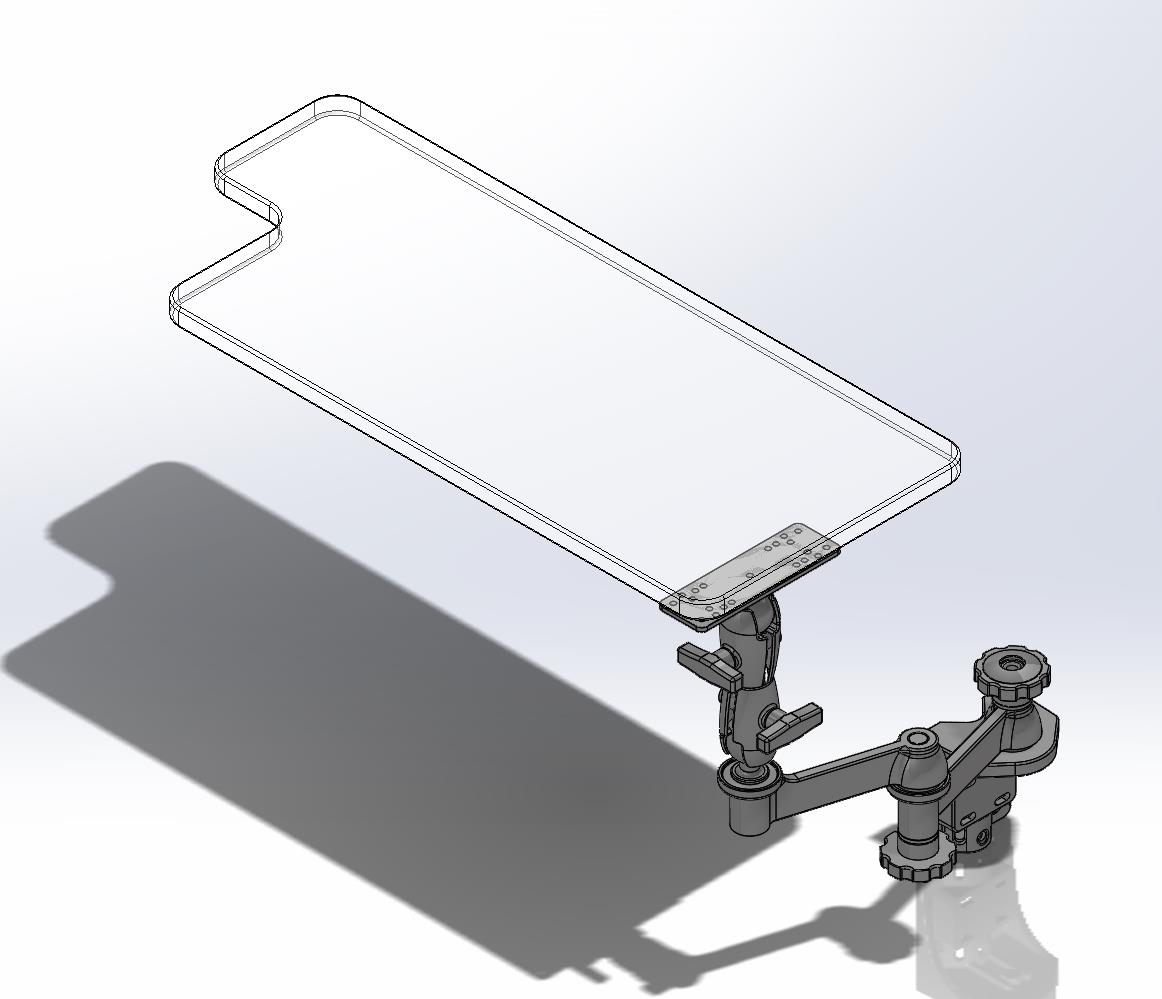
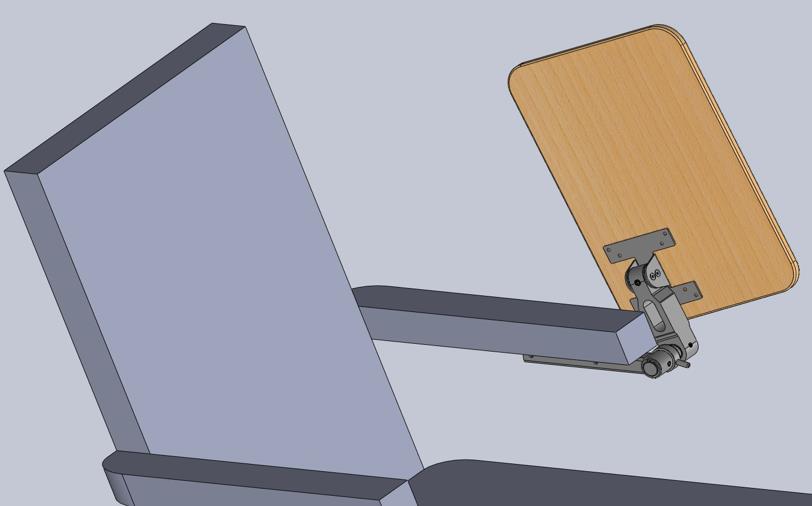
Design Solution
The final solution utilizes a gas spring mounting arm for smooth motions between stowage and usage. The tabletop is made from polycarbonate, providing a strong surface for the user to place belongings on while allowing the user to see their legs when the lap tray is deployed. Edges of the tabletop and other components are smoothed down for safer use. The mount is secured along the seat tracks beside the user to prohibit any interference with the user. In addition to the gas spring feature of this design, a unique aspect included is armrest extensions for the user to secure the tabletop at different heights and stow the tabletop when not in use. In a few fluid motions, the tabletop can move from a usable position to a vertical position beside the user secured by a stowage lever. The solution is designed so users with limited dexterity will be able to maneuver the tabletop by themselves once it has been properly mounted.
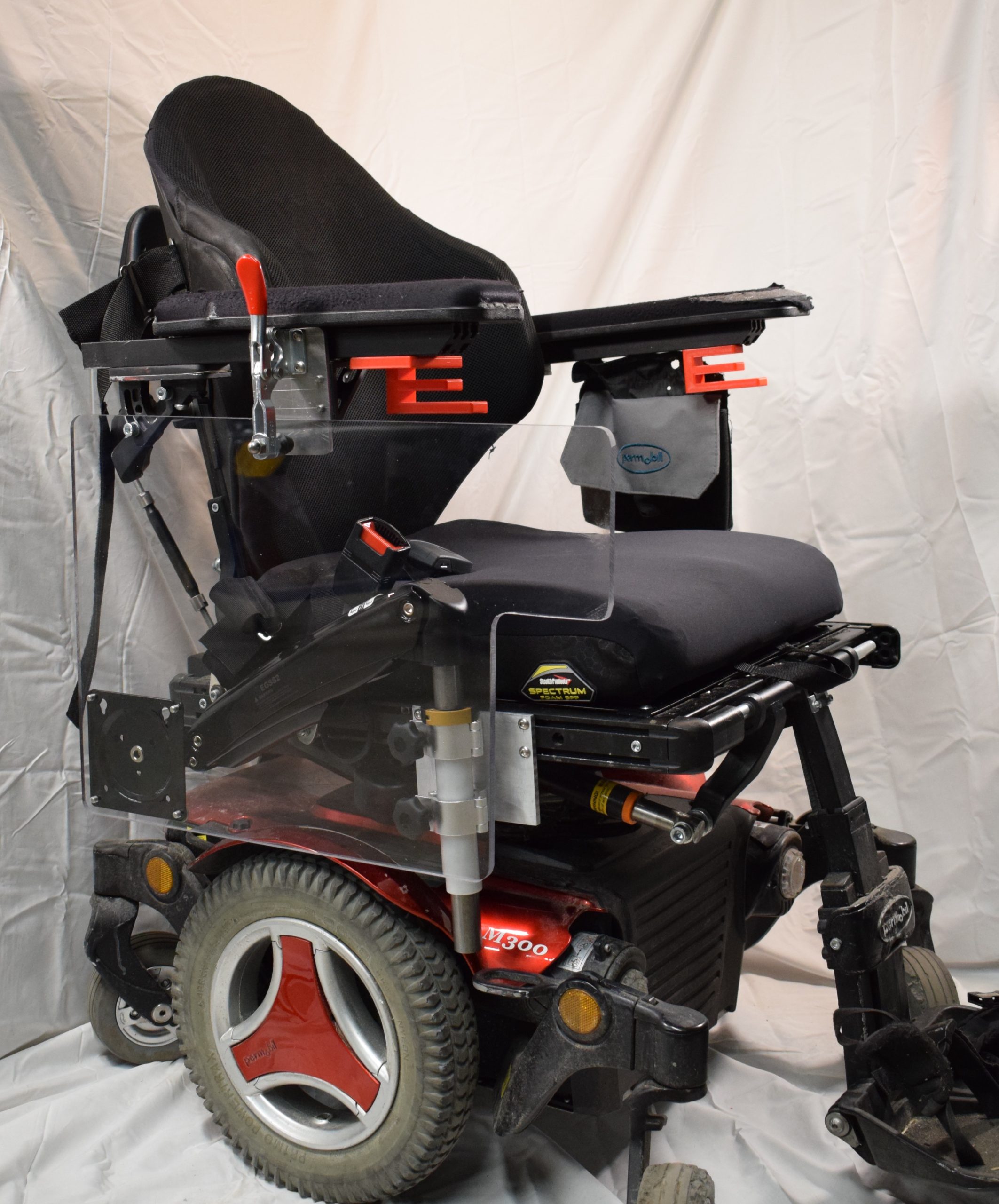
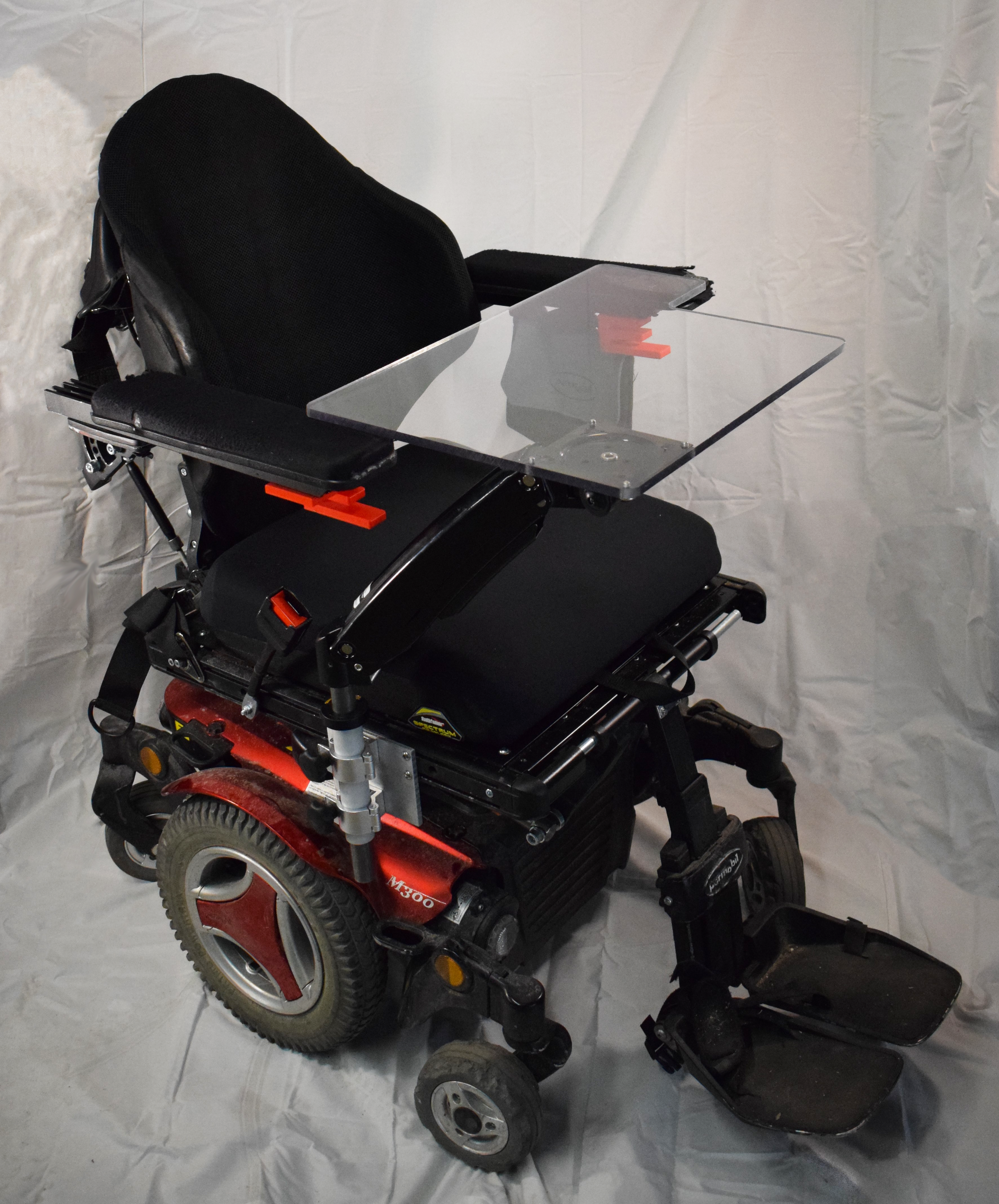
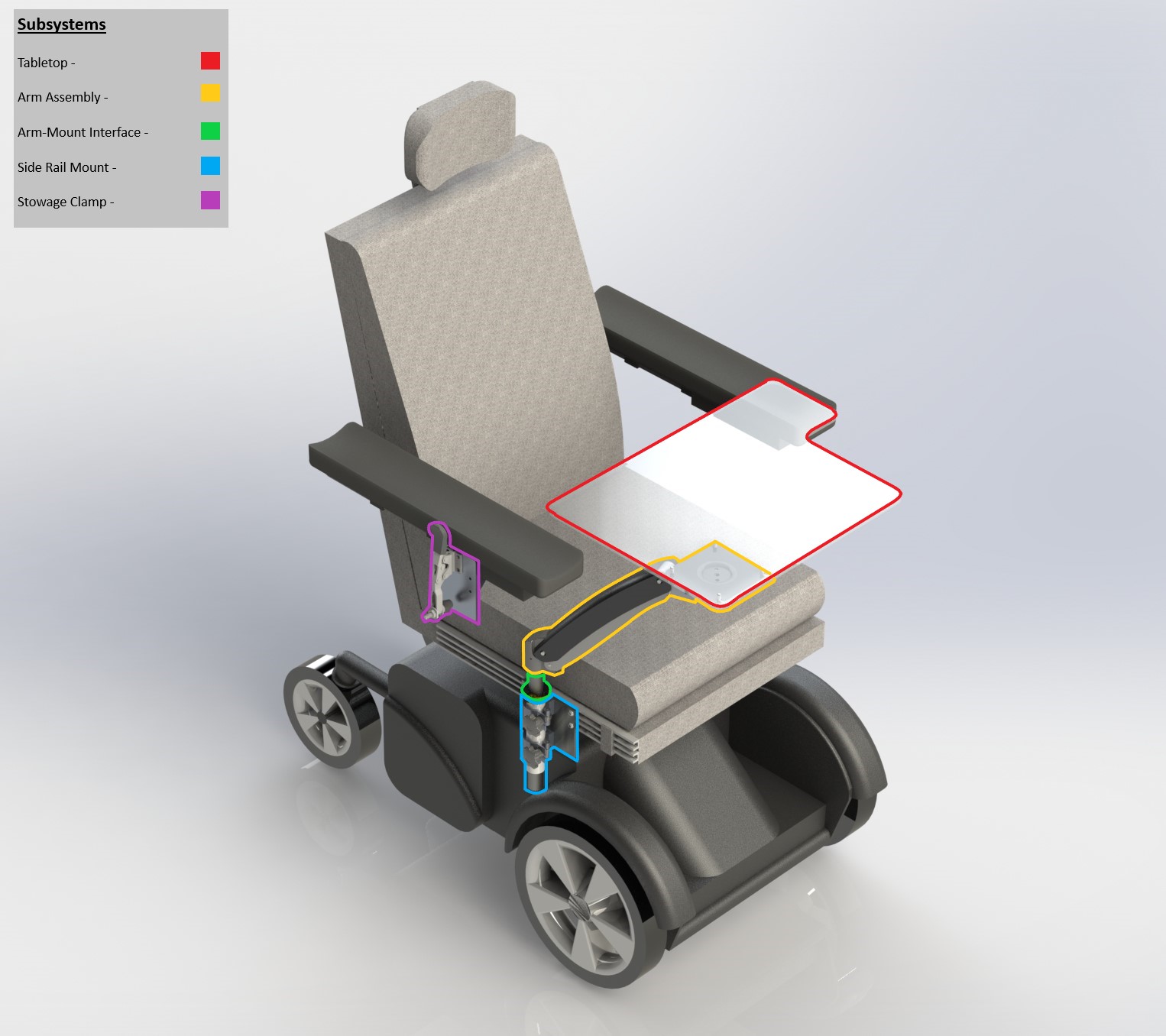
Tabletop
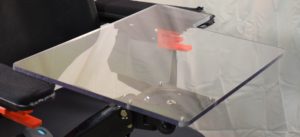 The team chose to use a 15x21x3/8 inch sheet of polycarbonate for a final tabletop material. Initially, acrylic was used, but after further investigation and review, the team made the decision to move to polycarbonate to better align with the standards already used at Craig Hospital. There is a cutout measuring 4 inches wide and 8 inches long on the side opposite the mounting system. This cutout was optimized to provide users with easy access to any controls or features that often protrude in front of the armrest. Additionally, the cutout was optimized to prevent any structural instability in the tabletop when a load is present. To mount the tabletop to the arm, four threaded holes are placed in a 100mm by 100mm square. The use of threaded holes for mounting allows the tabletops orientation to be flipped in instances where the arm and its components need to be moved to the opposite side of the chair.
The team chose to use a 15x21x3/8 inch sheet of polycarbonate for a final tabletop material. Initially, acrylic was used, but after further investigation and review, the team made the decision to move to polycarbonate to better align with the standards already used at Craig Hospital. There is a cutout measuring 4 inches wide and 8 inches long on the side opposite the mounting system. This cutout was optimized to provide users with easy access to any controls or features that often protrude in front of the armrest. Additionally, the cutout was optimized to prevent any structural instability in the tabletop when a load is present. To mount the tabletop to the arm, four threaded holes are placed in a 100mm by 100mm square. The use of threaded holes for mounting allows the tabletops orientation to be flipped in instances where the arm and its components need to be moved to the opposite side of the chair.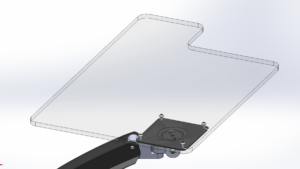
Arm Assembly
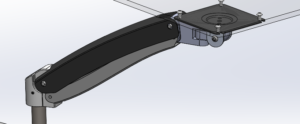 The arm assembly used in the final design consists of a gas-spring monitor arm. The purpose of the gas spring in the arm is to assist users in moving the assembly as a whole. The gas spring allows the user to move the tabletop vertically with ease. The arm also provides multiple degrees of freedom for the user and is an integral component for stowing the tabletop securely.
The arm assembly used in the final design consists of a gas-spring monitor arm. The purpose of the gas spring in the arm is to assist users in moving the assembly as a whole. The gas spring allows the user to move the tabletop vertically with ease. The arm also provides multiple degrees of freedom for the user and is an integral component for stowing the tabletop securely.
The connection between the tabletop and the arm assembly is done through the use of 4 bolts threaded into the tabletop as discussed in the previous section. The arm itself requires no modification from its initial state besides the adjustment of the gas spring using an Allen wrench that comes with the arm. To secure the arm to the mounting assembly, a setscrew is tightened at the connection between the shaft and the arm.
Arm-Mount Interface
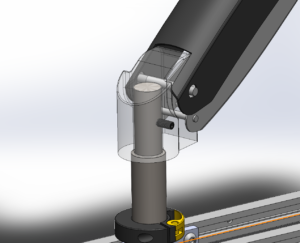 As covered in the previous section, the arm is mounted to the shaft of the system using a set screw. The photo provided shows a view of the system. The height of the overall system is adjustable using the toggle-locking shaft collar seen at the bottom of the image. The collar is connected directly to the steel shaft to prevent the shaft from moving lower inside the Delrin sleeve (Seen in the following section).
As covered in the previous section, the arm is mounted to the shaft of the system using a set screw. The photo provided shows a view of the system. The height of the overall system is adjustable using the toggle-locking shaft collar seen at the bottom of the image. The collar is connected directly to the steel shaft to prevent the shaft from moving lower inside the Delrin sleeve (Seen in the following section).
Side Rail Mount
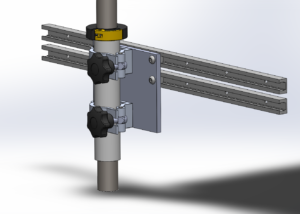 The mounting system is the subsystem that arguably required the most work overall from the team. The steel shaft as described previously is seated inside a Delrin sleeve which is then held to the system using the two clamps as seen in the image to the left.
The mounting system is the subsystem that arguably required the most work overall from the team. The steel shaft as described previously is seated inside a Delrin sleeve which is then held to the system using the two clamps as seen in the image to the left.
The collar rests on top of the Delrin sleeve, effectively setting the overall height of the system. The Delrin sleeve will be discussed later in the “Next Steps” section as this component is one the team believes could be improved.
To mount the entire system to the wheelchair, the backplate uses four M6x1 bolts and matching square nuts. This hardware directly matches the hardware that is typically used for other accessories on motorized wheelchairs. The team chose this hardware to provide the future manufacturer with more ease in production. The backplate can slide onto the side rail of the chair.
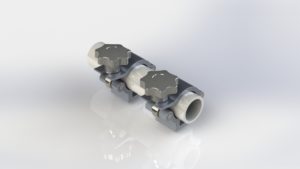
The clamps (as seen above) are tightened onto the Delrin sleeve, effectively acting as a lubricated slot for the steel shaft to rotate with the whole system.
Stowage Clamp
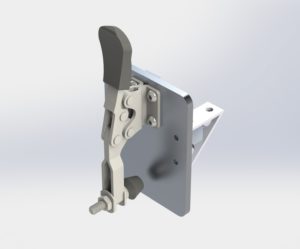 The stowage clamp utilizes a lever that is mounted beside the armrest on the side of the table. This lever can be operated by any user regardless of hand function. Flipping the lever securely holds the table in its vertical position against the plate that the lever is mounted to. While secured, the table’s translational and rotational motion is restricted, keeping the table in a safe position while it is not in use.
The stowage clamp utilizes a lever that is mounted beside the armrest on the side of the table. This lever can be operated by any user regardless of hand function. Flipping the lever securely holds the table in its vertical position against the plate that the lever is mounted to. While secured, the table’s translational and rotational motion is restricted, keeping the table in a safe position while it is not in use.
The clamp itself is mounted to the armrest rail on a mount plate and triangular brackets both consisting of aluminum. All hardware used for the mount plate is consistent with the M6x1 bolts used throughout the final design.
Next Steps
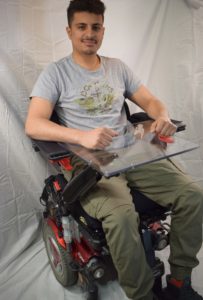 The majority of the criteria set forward for this project have been successfully achieved by Team Aspire. The aspects of the final design that could be improved upon include assembly/disassembly duration, adjustability by users after mounting, and tabletop material safety. Initially, the team believed it would be feasible to install the lap tray assembly in less than a minute. Although team members can install the mount, stowage attachment, and the linked arm and tabletop quickly, it takes longer than a minute and would take longer for a caretaker to assemble, even with instructions. The team has simplified many aspects of the assembly by designing most components to be installed on one side of the wheelchair, utilizing tracks alongside the seat and armrests, and attaching complicated components together. As for user adjustability, many alterations have been made to the apparatus to increase ease of use by consumers.
The majority of the criteria set forward for this project have been successfully achieved by Team Aspire. The aspects of the final design that could be improved upon include assembly/disassembly duration, adjustability by users after mounting, and tabletop material safety. Initially, the team believed it would be feasible to install the lap tray assembly in less than a minute. Although team members can install the mount, stowage attachment, and the linked arm and tabletop quickly, it takes longer than a minute and would take longer for a caretaker to assemble, even with instructions. The team has simplified many aspects of the assembly by designing most components to be installed on one side of the wheelchair, utilizing tracks alongside the seat and armrests, and attaching complicated components together. As for user adjustability, many alterations have been made to the apparatus to increase ease of use by consumers.
The final design utilizes a lever for stowage that does not require hand dexterity, and once mounted, the tabletop can be rotated, raised, and moved from side-to-side with little force; however, users with limited use of back muscles or upper arm muscles may struggle with some adjustments when deploying the tabletop. The level of caretaker assistance required varies depending on each user. The final lap tray has curved edges and can withstand high loads without buckling or fracturing, but the surface can be scratched. This risk is small, but any risk is an important consideration when validating a complex design. As a final iteration, the team will make a final modification to the Delrin sleeve that holds the mount post. This iteration will successfully fix the sleeve in place and prevent it from having any vertical translation (Image Below). 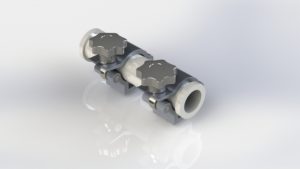
Meet the Team
Hamood Al-Harthi
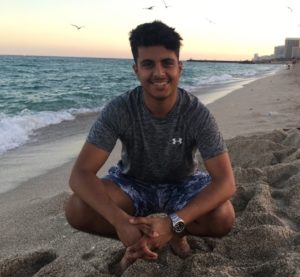
Hamood is an international student from Oman. He likes to spend a lot of time at the beach fishing, wakeboarding, kayaking, and snorkeling. In his free time, he likes to play golf, go hiking, or go out for dinner. Looking forward, he plans to do my master’s in renewable energy at the University of Edinburgh in Scotland. He is very excited about joining the energy sector and applying the knowledge and skills he has learned here at the Colorado School of Mines. Over the course of his time here in America, he got a chance to meet the most interesting people which made him more curious about the world. He hopes to be fortunate enough to come back to the U.S and visit other parts of the world.
Maxwell Hacker
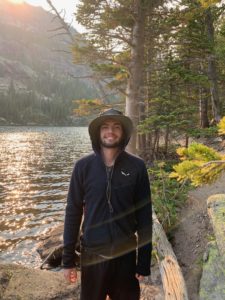 Max was born in Houston, Texas, but his family split their time between there and Estes Park for most of his childhood. He loves hiking, climbing, snowboarding, or anything else that involves getting out in the mountains. Max always knew he wanted to be an engineer, so Mines was the natural choice given its proximity to the mountains. After graduation, Max plans on transitioning from his role as an intern to a full-time position as a test director at NASA JSC. He has really enjoyed his time at Mines with getting to meet so many interesting people and work on as many interesting projects.
Max was born in Houston, Texas, but his family split their time between there and Estes Park for most of his childhood. He loves hiking, climbing, snowboarding, or anything else that involves getting out in the mountains. Max always knew he wanted to be an engineer, so Mines was the natural choice given its proximity to the mountains. After graduation, Max plans on transitioning from his role as an intern to a full-time position as a test director at NASA JSC. He has really enjoyed his time at Mines with getting to meet so many interesting people and work on as many interesting projects.
Clinton Hemphill
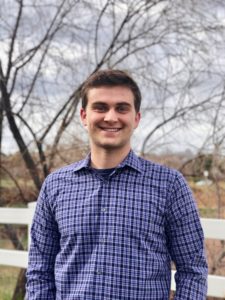 Clinton was born in Denver, Colorado, and has lived in Colorado for all his life. For the past four years, he has called Golden, Colorado his second home. In his free time, he enjoys fly-fishing, skiing, off-roading, camping, and just about any other outdoor activity found in Colorado. He is still searching for a full-time position to begin his career after Mines. He has learned a great deal at Mines over the past four years and is excited to bring this knowledge forward to his career as an engineer. The past two semesters in Senior Design have been incredibly valuable to him. Being a part of Team Aspire has been a fantastic experience and he is proud of the team’s ability to work together so well. He is also very proud of what the team was able to accomplish during such a unique time for students. Overall, he is very thankful to have been able to call the Colorado School of Mines his home over the past few years.
Clinton was born in Denver, Colorado, and has lived in Colorado for all his life. For the past four years, he has called Golden, Colorado his second home. In his free time, he enjoys fly-fishing, skiing, off-roading, camping, and just about any other outdoor activity found in Colorado. He is still searching for a full-time position to begin his career after Mines. He has learned a great deal at Mines over the past four years and is excited to bring this knowledge forward to his career as an engineer. The past two semesters in Senior Design have been incredibly valuable to him. Being a part of Team Aspire has been a fantastic experience and he is proud of the team’s ability to work together so well. He is also very proud of what the team was able to accomplish during such a unique time for students. Overall, he is very thankful to have been able to call the Colorado School of Mines his home over the past few years.
Emma Myhre
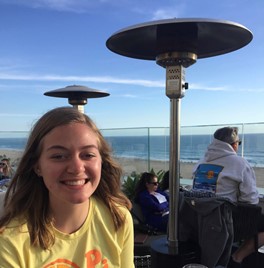 Before coming to Colorado, Emma lived in Granite Falls, Washington, and a few towns in Montana. She enjoys biking and hiking (as well as most outdoor activities) and playing card games with friends. She came to Mines to follow her brother Taggert, who graduated with his mechanical engineering degree last year. Luckily, Emma ended up liking engineering even though she knew nothing about it before Mines. After graduation, she’ll be working as a Field Engineer for HPM Contracting in Englewood, CO. She has enjoyed getting to know her senior design team and she’s grateful for the opportunity they had to work on a unique and hands-on project.
Before coming to Colorado, Emma lived in Granite Falls, Washington, and a few towns in Montana. She enjoys biking and hiking (as well as most outdoor activities) and playing card games with friends. She came to Mines to follow her brother Taggert, who graduated with his mechanical engineering degree last year. Luckily, Emma ended up liking engineering even though she knew nothing about it before Mines. After graduation, she’ll be working as a Field Engineer for HPM Contracting in Englewood, CO. She has enjoyed getting to know her senior design team and she’s grateful for the opportunity they had to work on a unique and hands-on project.
Chelsea Pearson
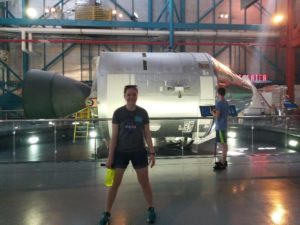 Chelsea was born and raised in Broomfield, Colorado, and she is going to be sad when she has to leave Colorado! She has spent half of her life outside playing soccer and exploring the mountains. After graduation she will be joining the Air Force as a 2nd Lieutenant, heading down to Florida for training. She is looking forward to traveling as much as she can with the Air Force and expanding her horizons. Mines has been excellent preparation for that life, and though she probably won’t be using my mechanical engineering degree very much, she will be using all the skills it took to earn that degree. She is so glad to have had this opportunity to get to know her team for senior design, and she’s really proud of what the team has done!
Chelsea was born and raised in Broomfield, Colorado, and she is going to be sad when she has to leave Colorado! She has spent half of her life outside playing soccer and exploring the mountains. After graduation she will be joining the Air Force as a 2nd Lieutenant, heading down to Florida for training. She is looking forward to traveling as much as she can with the Air Force and expanding her horizons. Mines has been excellent preparation for that life, and though she probably won’t be using my mechanical engineering degree very much, she will be using all the skills it took to earn that degree. She is so glad to have had this opportunity to get to know her team for senior design, and she’s really proud of what the team has done!
Grant Scott
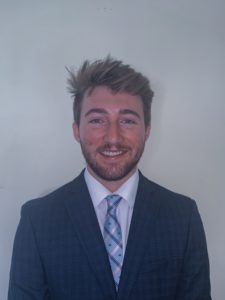
Grant is a graduating senior originally from Thornton Colorado but has loved making Golden his second home for these past four years. He enjoys being outdoors and being active, including lap swimming and camping in the mountains. After graduation, he plans to continue his job search for full-time employment in the mechanical engineering field. Grant has enjoyed the last two semesters working on this project with his team. They are proud of the work they’ve put in and they are excited to present the final product. Grant is also very appreciative that he had the opportunity to meet so many friends, learn so many skills and earn such a wonderful degree from the Colorado School of Mines.

